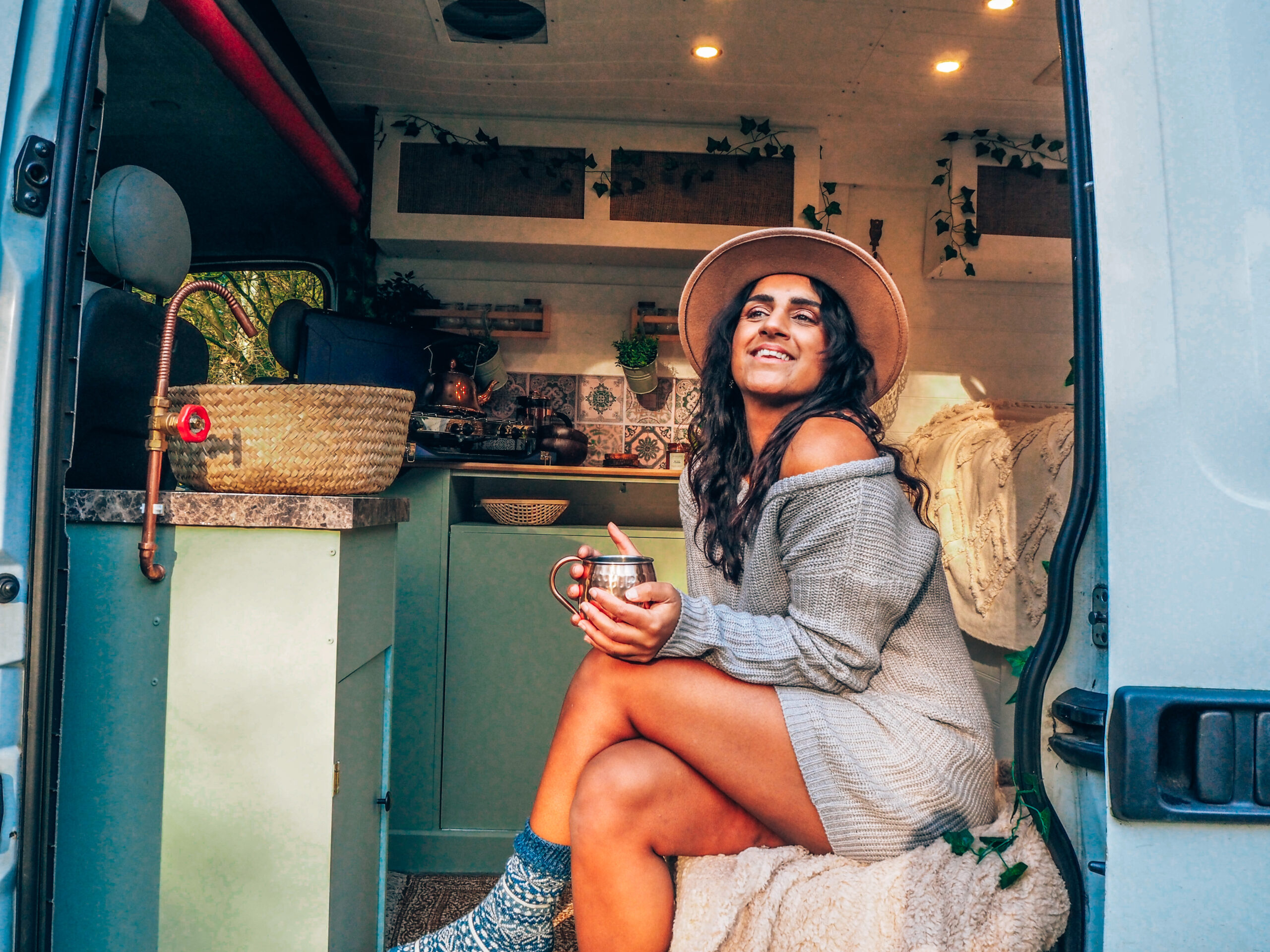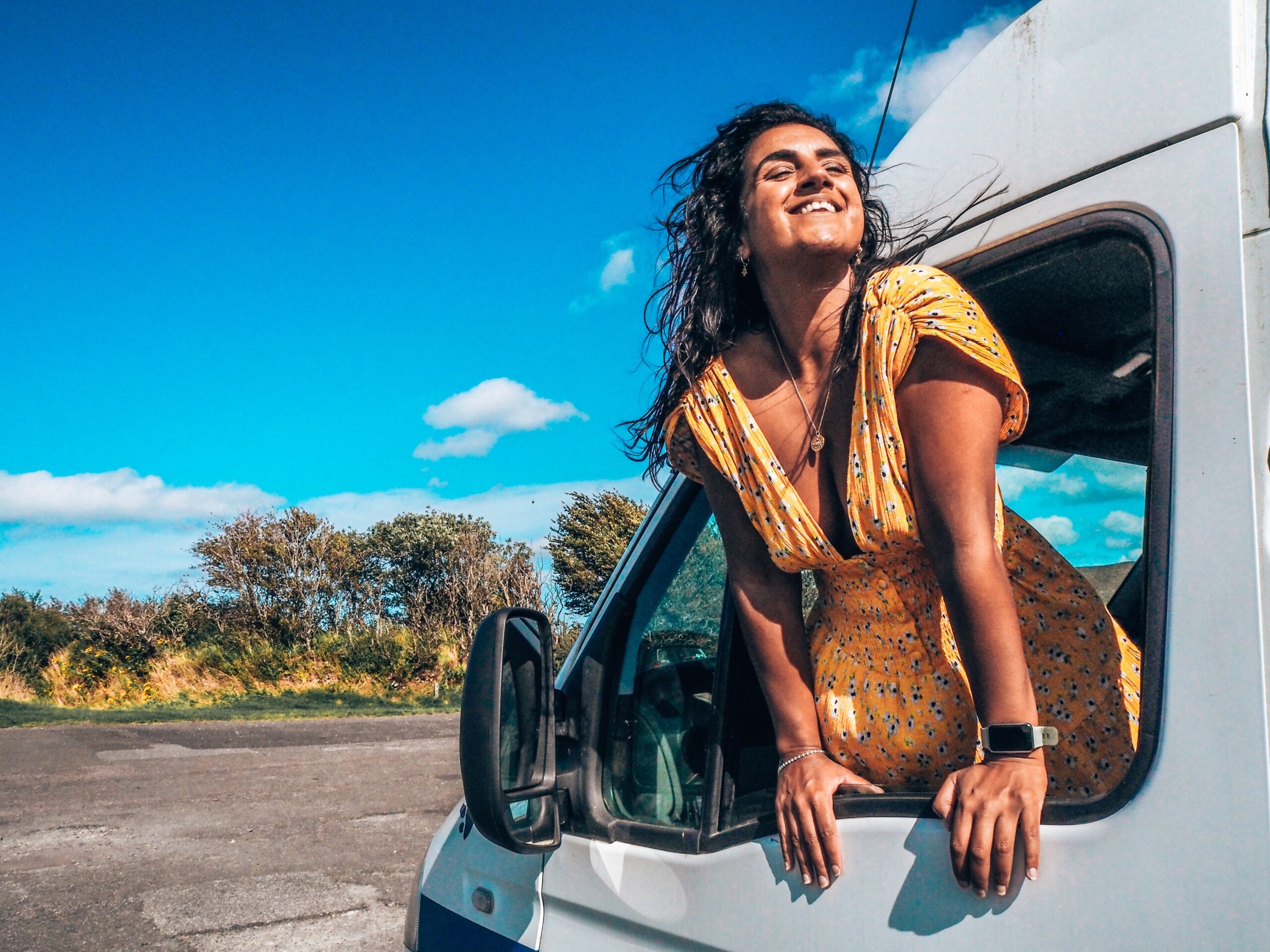Entering the world of solo female vanlife is such an exciting and brave move, it’s enough to give you butterflies. It’s an opportunity to depend on yourself, trust your intuition, and build memories backed by vanlife safety knowledge. Travelling alone is the ultimate way to grow and find independence wherever you are on the road.
So, what are some vanlife safety tips for solo female travellers?
Vanlife safety tips for solo female vanlife travellers include being able to access the cab from inside the van, carrying useful safety gadgets such as an alarm or external light, using apps, creating a dependable support network so loved ones know where you are, and above all, trusting your intuition.
Solo exploration in a home on wheels can be a wonderful experience, but it’s vital not to be caught up in the moment and forget about the importance of vanlife safety. Keeping secure in your campervan will not only increase your confidence but will also ensure you’re safe and ready to tackle any adventures in any location!
| >> CLICK HERE TO SHOP MY VANLIFE ESSENTIALS << |
|---|

Stealth Camping vs Campsites (And The Best Way To Find Them)
I’m a lover of finding wild spots to park my campervan for the night, and provided I have permission and there aren’t any ‘no overnight parking’ signs, these park-ups are my go-to’s. Stealth camping and wild camping go hand in hand as they both represent parking a campervan away from a campsite, but what are the key differences between this kind of parking, and staying at a campsite?
Read: Wild Camping For Campervans In The UK (2024 Guide)
Stealth Camping
Stealth camping is the act of parking away from a campsite (or an aire if you’re in Europe). This can mean rocking up in a wilderness spot, nestled in the trees, or it can also refer to pulling up on a residential street. It has many benefits from free parking and close proximity to shops and amenities, but it’s something that’s getting increasingly difficult here in the UK.
Some areas such as the Lake District in the north of the UK generally tolerate wild or stealth camping provided campers are respectful of their actions while visiting the area. This means the ability to open up your camper and have nature on your doorstep. When stealth camping, it’s essential to keep noise to a minimum, leave no trace, and move calmly if a ranger or National Park employee requests you move onward to a new spot.
Campsites
I view campsites as luxury locations where I can freshen up, complete a few loads of laundry, plug my camper in, and generally reset for a few days before heading off into the trees again. Campsites are an investment in the UK costing anywhere from £15+/night, and often this doesn’t include the price for laundry, electric hook-up, or showers. There are countless advantages to staying at campsites including increased security for enhanced vanlife safety, helpful staff, and various useful amenities.
To find the best stealth camping spots and campsites, I search on Google Maps, preferring to hunt around for hidden gems than head to the most obvious (and usually busiest) locations. Parking apps worth remembering are park4night, SearchForSites, and BritStops.
| >> CLICK HERE TO SHOP MY VANLIFE ESSENTIALS << |
|---|

Vanlife Security Tips
Heading into solo female vanlife is exhilarating; take it from someone who has spent countless nights alone in their van across the country! At times, it can be challenging, but having good vanlife safety knowledge alongside vanlife security tips is key to transforming nerves into excitement.
Having Access To The Cab From Inside
A huge debate in the vanlife world, especially for those completing a self-build, is whether or not to remove the bulkhead that comes standard with many vans. A bulkhead is in place to separate the cab or driving area of a van from the rest of the space in the rear. This is great if you want complete separation between the driver’s seat and the living area, but it isn’t the safest choice.
By keeping a bulkhead in place, you will only be able to access the cab from outside the van, by the driver’s or front passenger door. In situations where you don’t feel comfortable or safe and want to drive to a new spot, having to get out of the van can feel daunting. Removing the bulkhead and having access to the cab from inside means you can stay locked in your van, climb into the front, start the engine, and drive away quickly should the moment call for it.
Vanlife Safety Tip: If you’re set on keeping the bulkhead in your van, but you’re worried about it potentially compromising your safety in the future, I’d recommend creating a walkway or hatch you can climb through. This means you get the best of both worlds; a partial bulkhead for distinguished separation, and a route to the driver’s seat that doesn’t involve unlocking doors and getting out of your campervan.
Carrying Useful Safety Gadgets
Thankfully, in today’s modern world with ever-changing technology, there are numerous safety gadgets we can install in our campervans. Regardless of whether you’re exploring solo female vanlife, or you’re a travel pro adventuring with a partner, installing simple items such as alarms, a deadlock on rear or sliding doors, and external lights can be a game-changer in terms of safety.
Utilising Apps
Apps are a fantastic way of increasing vanlife safety with most being free or having a minimal cost. They tend to have similar features such as location sharing with selected contacts, panic alerts, and sometimes even direct links to monitoring centres when an alarm is activated. Popular apps include Hollie Guard, WalkSafe, and Safetipin.
Read: How To Get Wifi For Your Campervan
Creating A Dependable Support Network
A support network is fundamental for solo travel. It’s a gateway to safety where trusted family and friends know where you are, your travel plans for the next few days, and when you will be getting in contact next. This increases vanlife safety while travelling as it means there are loved ones who are up-to-date with your travels and will know if something isn’t quite right.
Only sharing your location with trusted individuals is vital, so even if you have booming social media accounts, it’s best to avoid publishing your live location to the public. You never know who else might be in the area and when you have hundreds or thousands of followers, it’s impossible to know exactly who every person is, and whether they can be trusted.
Vanlife Safety Tip: Using social media is a daily for many of us, and there’s so much joy in sharing pictures, collaborating with others, and exchanging travel tips online. However, when exploring the world solo, it’s safer to post when you’ve moved on from the location you’re sharing pictures or videos from, so strangers cannot track your location.
Trust your Gut
Intuition can be powerful. It gives us fluttering stomachs and sweaty palms when we feel something isn’t right, and it’s the little voice in your head that nudges you to act cautiously. Whether you’re parked at the most gorgeous, scenic spot or a buzzing park-up full of campers, trust your gut if it becomes unsettled and makes you question your safety.
It’s never a bad decision to move somewhere else, even if new friends or campers are encouraging you to stay. Believe in your abilities to best assess the situation and source an outcome that will make you feel safe and at ease – if this is moving location, do it!
| >> CLICK HERE TO SHOP MY VANLIFE ESSENTIALS << |
|---|

3 Things To Look Out For And Avoid When Finding Park-Ups
There are a few non-negotiables to look out for when attempting to find somewhere to park your campervan for the night. Arriving at a destination during the day is your best bet to scout out the area before deciding to get comfortable and park for the night. It allows you to get a feel for the location, see who’s around, and assess if it’s a secure location to sleep.
Unfriendly Vibe
Energies are strong, and if you feel an unfriendly vibe from other campers, locals, or from a nearby town or village, it’s best to move on. Sadly, vanlife or campervan travel isn’t tolerated by everyone and this can lead people to see this form of travel in a negative light. Whether you notice angry expressions from locals or rowdy campers setting up nearby, it’s best to jump back in the front seat and give another spot a try.
Lack Of Safety Features
Wild parking spots don’t tend to come with much at all, since they are areas in nature. Campsites, on the other hand, should be well-lit, with a secured entrance and exit gate, helpful staff, and emergency equipment such as fire extinguishers and a defibrillator available. If you rock up and realise the campsite you planned to stay at isn’t as secure as you initially thought, seek out another site that will have you feeling safe and secure.
Low Or No Lighting
Low lighting is a big no for me! Unless I’m in the depths of a National Park or have chosen a beach park up for the night, I like to be able to see what’s going on in my immediate environment. This is crucial for solo female vanlife as I like to keep an eye on anyone showing extended interest in my van, or generally hanging around without an obvious reason. For areas where lighting is nearly impossible, such as wild park ups, I turn on my exterior light to better see what’s happening around me.
Is It Safe For Women To Travel Solo In A Campervan?
For some, the idea of travelling in a campervan solo is hard to comprehend, while others understand the fire for life and adventure so many of us seek. By taking the necessary safety precautions such as carrying a personal alarm, installing safety equipment in your van, and keeping observational of the surrounding area, it’s safe for women to travel solo in a campervan.
| >> CLICK HERE TO SHOP MY VANLIFE ESSENTIALS << |
|---|













